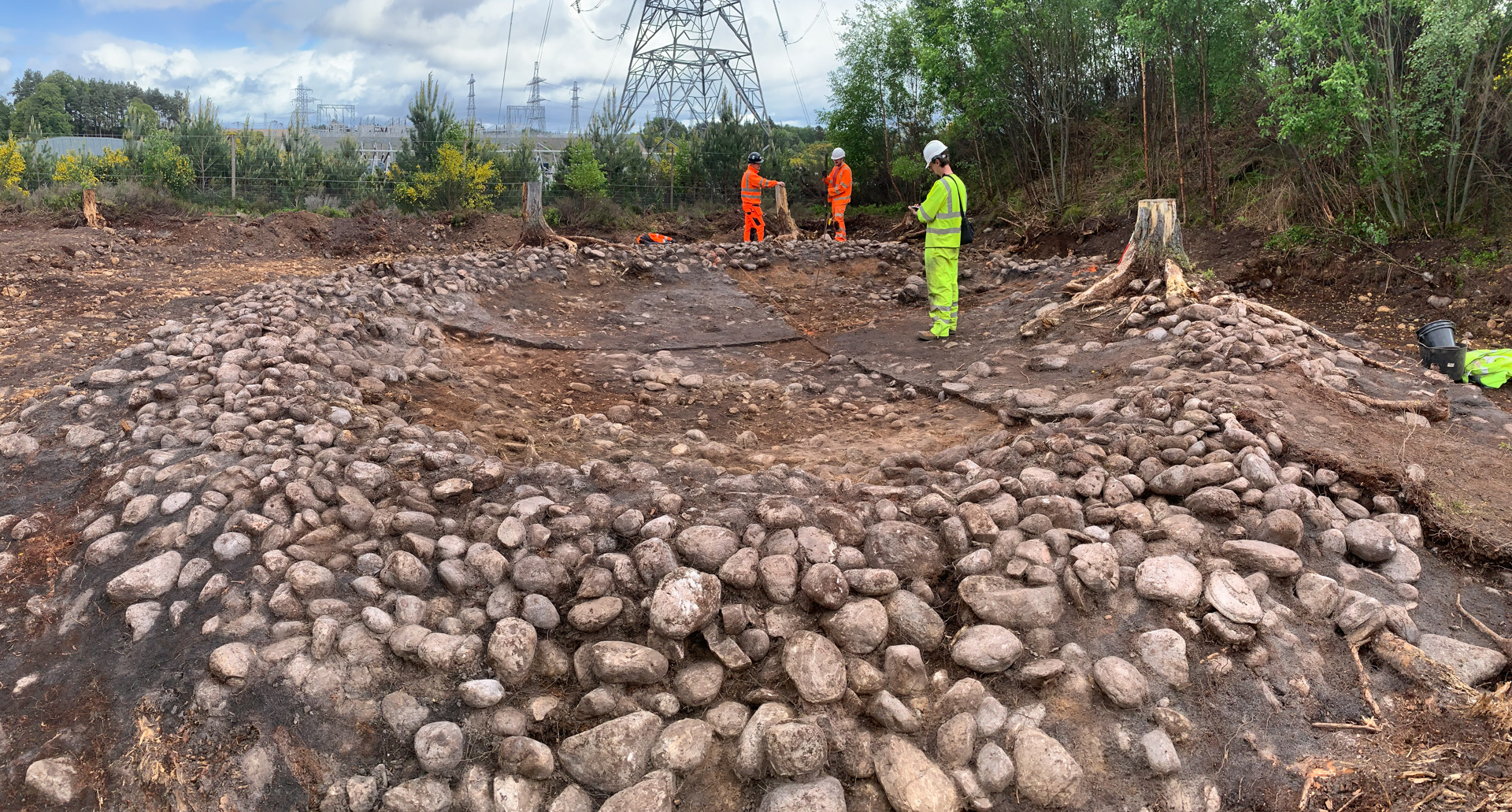At Balblair Wood, on a terrace above River Beauly, near Inverness, the remains of prehistoric settlement lie hidden between a modern substation and quarry.
In 2022, a proposed extension to Beauly Substation has allowed the excavation of a hut circle within this group of prehistoric features, revealing evidence of a domestic structure.
AOC Archaeology undertook the excavation work for WSP UK on behalf of Scottish & Southern Electricity Networks.
Balblair Wood
Within Balblair Wood, several prehistoric sites are known along a river terrace on the north side of River Beauly. These include several hut circles, clearance cairns and linear banks alongside burial cairns and a possible burnt mound. Over the years, expansion of the Substation and nearby quarry have required excavation of some of the features. A round cairn excavated in 2004 revealed a stone cist burial chamber with fragments of Early Bronze Age pottery (MHG29161). Many of the other cairns in the area have also been investigated and were found to be agricultural clearance cairns of prehistoric date.
The Hut Circle
The hut circle at Beauly Substation was first identified during a walkover survey in 1999 (EHG104). It appeared as a circular turf and stone bank of 12m diameter with a slight dip on the southeast side suggestive of an entrance. Hut circles are a common site type found across northern Scotland but can be notoriously difficult to characterise without excavation. This is because the site type has persisted throughout prehistory into medieval and later times and can have a variety of functions, though most are thought to be dwelling houses. Initial survey of this hut circle suggested that it was probably a roundhouse, but the presence of other burial cairns nearby meant there was potential for this to be a burial monument.
The Excavation
Excavation of the hut circle was carried out over five weeks in the summer of 2022. The structure was formed by a substantial stone and turf bank, spread up to 2m wide, and disturbed by several large tree stumps. The original wall foundation was identified as a turf deposit overlain by structural stones, with the spread on either side representing material that had collapsed after the abandonment of the site.
There was a break in the bank on the southeast side and it is likely that this was the location of the entrance. The entrance may have had a small post-built porch with a cobbled surface.
Inside the structure, an oval alignment of postholes was found, which would have formed a ring of timber posts to hold the roof. There were stones packed at the edges and base of some of these postholes to help support the structure. Smaller postholes noted alongside the main ring might have been used as prop supports during the construction or repair of the house. Other postholes nearer the centre of the house suggest possible internal partitions.
Small Finds
A very small assemblage of finds was recovered from the excavation. Two flint artefacts came from the collapsed turf on the inside of the house, one of which is a possible thumb scraper. Flint objects had many functional uses in hunting, cooking, and craft activities.
Two fragments of saddle querns were found amidst the collapsed stone of the banks, both deposited with their working side face down. Saddle querns are a common artefact from prehistoric sites and were used as a flat or dished surface for grinding cereal grains into flour. They would have been used in conjunction with a smaller rubbing stone.
Several fragments of prehistoric pottery also came from below the possible cobbled surface within the entrance to the house.
Ongoing Research
Although the excavation at Beauly Substation is now complete, research into the hut circle is still ongoing. This post-excavation work will focus on analysis of the small finds and bulk soil samples collected during the fieldwork. This is a key part of the investigations into the hut circle and will allow the recovery of environmental remains such as grains, seeds, and charcoal, which can reveal information about the cultivated and wild resources used by the people who lived at the site. These analyses will also provide material for radiocarbon dates to help refine the date range within which the roundhouse was inhabited.
Further Reading
Becket, A. 2014. Western Isles Converter Station: Archaeological Excavation Data Structure Report, Balblair Woods, Beauly, Highland. Unpublished Northlight Heritage report.
Neighbour, T. 1999. Balblair Wood, Beauly, Archaeological Survey. Unpublished CFA report.











